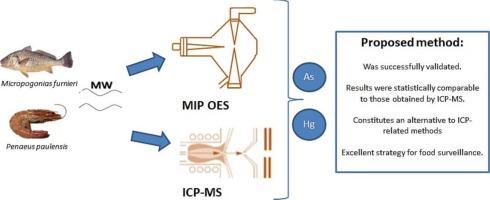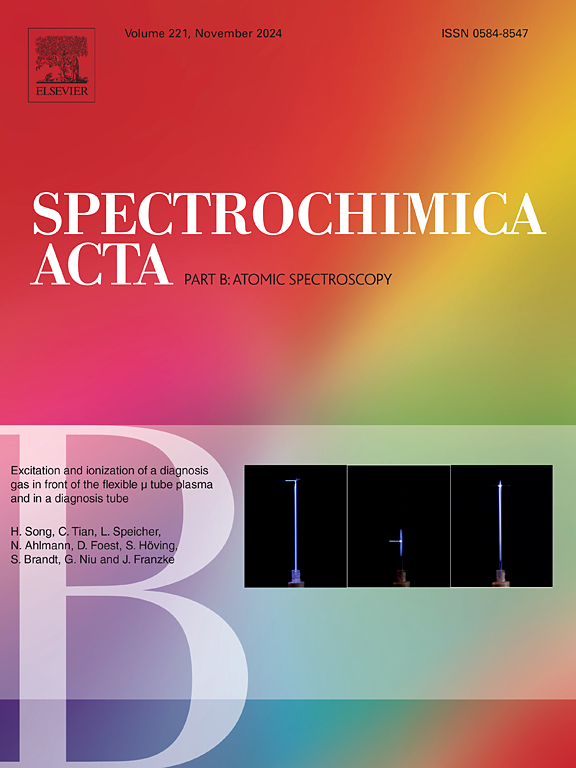Microwave-induced plasma optical emission spectrometry coupled to vapor generation (VG-MIP OES) as an alternative technique for As and Hg determination for seafood surveillance
IF 3.8
2区 化学
Q1 SPECTROSCOPY
引用次数: 0
Abstract
Fish and crustaceans can absorb inorganic contaminants such as arsenic (As) and mercury (Hg) from sediments and water. The assessment of these potentially toxic contaminants in fishing resources is of utmost importance to ensure human health and food safety using reliable analytical methods that allow its determination. The standard techniques used for its determination are atomic spectrometry, absorption or fluorescence, or inductively coupled plasma–mass spectrometry (ICP-MS). Here we proposed the application of cold vapor coupled to microwave-induced plasma optical emission spectrometry (CV-MIP OES) to determine Hg and the use of hydride generation (HG-MIP OES) to determine As. We present an exhaustive optimization of the volatile generation and analytical parameters. Both volatile contaminants were determined in muscle of a benthic crustacean (Penaeus paulensis, pink shrimp) and a carnivorous fish (Micropogonias furnieri, white croaker). Analytical performances were evaluated using certified reference materials of mussel tissue and dogfish liver. The methods' performance indicated no statistical differences between an ICP-MS-based procedure and the alternative proposed methods based on CV-MIP OES or HG-MIP OES. Hence, these methods can be postulated as alternatives to the commonly used techniques to assess the safety of seafood products. For the first time, potentially toxic elements were evaluated in wild pink shrimp.

微波诱导等离子体光学发射光谱耦合蒸汽产生(VG-MIP OES)作为海产品监测中砷和汞测定的替代技术
鱼类和甲壳类动物可以从沉积物和水中吸收无机污染物,如砷和汞。对渔业资源中这些潜在有毒污染物进行评估,对于使用可靠的分析方法确定其含量,确保人类健康和食品安全至关重要。用于其测定的标准技术是原子光谱法、吸收或荧光法或电感耦合等离子体质谱法(ICP-MS)。本文提出了冷蒸汽耦合微波诱导等离子体光学发射光谱法(CV-MIP OES)测定汞和氢化物生成法(Hg - mip OES)测定砷的方法。我们提出了一个详尽的优化挥发物的产生和分析参数。测定了底栖甲壳类动物(白对虾)和肉食性鱼类(白花鱼)肌肉中的两种挥发性污染物。采用经认证的贻贝组织和角鲨肝脏标准物质对分析性能进行了评价。这些方法的性能表明,基于icp - ms的方法与基于CV-MIP OES或HG-MIP OES的备选方法之间没有统计学差异。因此,这些方法可以作为评估海产品安全性的常用技术的替代方法。首次对野生粉虾的潜在毒性元素进行了评价。
本文章由计算机程序翻译,如有差异,请以英文原文为准。
求助全文
约1分钟内获得全文
求助全文
来源期刊
CiteScore
6.10
自引率
12.10%
发文量
173
审稿时长
81 days
期刊介绍:
Spectrochimica Acta Part B: Atomic Spectroscopy, is intended for the rapid publication of both original work and reviews in the following fields:
Atomic Emission (AES), Atomic Absorption (AAS) and Atomic Fluorescence (AFS) spectroscopy;
Mass Spectrometry (MS) for inorganic analysis covering Spark Source (SS-MS), Inductively Coupled Plasma (ICP-MS), Glow Discharge (GD-MS), and Secondary Ion Mass Spectrometry (SIMS).
Laser induced atomic spectroscopy for inorganic analysis, including non-linear optical laser spectroscopy, covering Laser Enhanced Ionization (LEI), Laser Induced Fluorescence (LIF), Resonance Ionization Spectroscopy (RIS) and Resonance Ionization Mass Spectrometry (RIMS); Laser Induced Breakdown Spectroscopy (LIBS); Cavity Ringdown Spectroscopy (CRDS), Laser Ablation Inductively Coupled Plasma Atomic Emission Spectroscopy (LA-ICP-AES) and Laser Ablation Inductively Coupled Plasma Mass Spectrometry (LA-ICP-MS).
X-ray spectrometry, X-ray Optics and Microanalysis, including X-ray fluorescence spectrometry (XRF) and related techniques, in particular Total-reflection X-ray Fluorescence Spectrometry (TXRF), and Synchrotron Radiation-excited Total reflection XRF (SR-TXRF).
Manuscripts dealing with (i) fundamentals, (ii) methodology development, (iii)instrumentation, and (iv) applications, can be submitted for publication.

 求助内容:
求助内容: 应助结果提醒方式:
应助结果提醒方式:


